2019 年浙江宁波大学翻译硕士英语考研真题
B. Provided C. Unless
D. While
B. turned over
C. turned away
D. turned off
D. have the last word
B. preserve
C. consume
B. have a word
C. have the word
Part I Vocabulary and Grammar (30 points: 20 for Section A, and 10 for Section B)
Section A: There are 20 incomplete sentences in this section. For each sentence there
are four choices marked A, B, C and D. Choose the ONE answer that best completes
the sentence.
1.Andrew wanted to be transferred to another department, but her application was
_____ because her own department is understaffed.
A.turned down
2.Helen’s been neglecting her homework lately. I’ll _____ with her parents about
it.
A.have words
3.______ more societies are geared to retirement at around 65, companies have a
looming problem of knowledge management.
A.Given that
4.Psychologists maintain that the nature of human beings entails a strong need to
_____ their free time; idleness can be as stressful as activity.
A.
D. organize
5._____ age twenty, Robert Kelly left KCRA, Inc. to enroll _____ the University of
California at Davis.
A. at; at
C. upon; in
6.We had the unmeasured _____ of the enemy and their air attack still beating upon
us.
A. threaten
7.I _____ the Head Master’s permission to alter darker to sterner. “Not less we
praise in sterner days.”
A. have obtained
8.AIDS is said __________ the number-one killer of both men and women over the past
few years in that region.
A. being
9.Sometimes he was brilliant; sometimes he was maddeningly tiresome. The underlined
word means ________.
A. exhausting
10.Uncle Bubba was tough, kind, funny, and scary all _________ one, which was just
what Dan and I needed.
A. mix into B. merged into
11.In fact, as he approached his beloved daughter, he only barely resisted the
________ to stroke her pretty soft hair.
A. impulse
12.The price of the organic vegetable will vary according to how far it has to be
transported and how expensive the freight ________ is.
A. payment
13.As the temperature dropped abruptly, the campers were ________ all over with cold.
C. to have been D. having been
B. dull C. annoying D. bored
B.
acquire C. had possessed
B. misfortune
C. flinch
C. fixed into
D. rolled into
B. charge
C. fund D. price
B. intuition
C. instinct D. incentive
D. contained
B. at; in
D. on; at
D. menace
endanger
B. to be
�
C. shaking
C. sought
D. attitude
D. furnished
D. staggering
B. in terms of
C. in quest of
A. spinning B. shivering
14.The English language contains a (an) ________ of words which are comparatively
seldom used in ordinary conversation.
A. altitude B. latitude C. multitude
15.The mayor expressed his heart-felt gratitude through the reporters for the timely
assistance and support the people from other cities had kindly ________ to his
citizens.
A. rendered B. secured
16.The younger person’s attraction to stereos cannot be explained only ________
familiarity with technology.
A. by means of
17.Lucy ________ going back to school since she saved enough money, but she hasn’t
decided yet.
A.considered
C.is going to consider
18.Many reporters hurried to the airport, ________ that the superstar had already
left.
A.had been told
C.only to be told
19.Once you become a soldier, you will be given a monthly ________ by the army.
A. income
C. wage
20.The Olympic Games ________ in 776 B. C. in Olympia, a small town in Greece.
A. originated
C. derived
B. being told
D. unfortunately told
D. has been considering
B. had considered
D. by virtue of
B. allowance
D. descended
D. salary
B. stemmed
22
23
21
Section B: There are 20 blanks in the following passage. For each blank there are
four choices marked, A, B, C, and D You should choose the ONE that best fits into
the passage. Then mark the corresponding letter on the Answer Sheet with a single
line through the centre.
In Cambodia the choice of a spouse is a complex one for the young male. It may involve
not only his parents and his friends,
those of the young women, but also a
a likely spouse on his own and them ask his parents
matchmaker. A young man can
the marriage negotiations. or the young man’s parents may make the choice
to
of a spouse, giving the child little to say in the selection.
, a girl may
a spouse has been selected, each
veto the spouse her parents have chosen.
family investigates the other to make sure its child is marrying
a good
family.
The traditional wedding is a long and colorful affair. Formerly it lasted three days
by the 1980s it more commonly lasted a day and a half. Buddhist priests offer
27
28
a short sermon and
prayers of blessing. Parts of the ceremony involve ritual
hair cutting,
29
cotton threads soaked in holy water around the bride’s and
groom’s wrists, and
respected couples to bless the
a candle around a circle of happily married and
. Newlyweds traditionally move in with the
24
25
26
31
30
�
with them up to a year,
33
they can build a flew
32
wife’s parents and may
house nearby.
Divorce is legal and easy to
36
with some disapproval. Each spouse retains
the marriage, and jointly –acquired property is
may remarry, but a gender prejudice
waiting period before he can remarry
39
40
34
, but not common .Divorced persons are
35
into
equally. Divorced persons
up .The divorced male doesn’t have a
property he or she
38
37
the woman must wait the months.
B. as well as
B. provide for
C. on behalf of
C. compete with
D. with regard to
D. decide on
C. arrange
D. postpone
C. In time
D. For example
D. Unless
D. through
D. so
C. from
C. recite
C. but
B. renew
B. within
B. or
B. copy
B. piling
21. A. by way of
22. A. adapt to
23. A. close
24. A. In theory
B. Above all
25. A. Although B. Lest C. After
26. A. into
27. A. sine
28. A. test
29. A. folding
30. A. lighting B. passing
31. A. meeting
32. A. grow B. part
33. A. whereas
34. A. obtain
35. A. isolated
36. A. wherever B. however
B. brought
37. A. changed
B. invested
38. A. divided
39. A. clears
B. warms
B. so what
40. A. while
B. until
B. follow
B. association
B. persuaded
C. wrapping
C. hiding
C. collection
D. live
C. deal
C. for
C. challenge
D. create
D. tying
D. serving
D. union
D. if
D. avoid
C. viewed
D. exposed
C. whenever
C. shaped
C. donated
C. shows
C. once
D. whatever
D. pushed
D. withdrawn
D. breaks
D. in that
Part II Reading Comprehension (40 points: 2×20)
Direction: There are four passages in this part. Each passage is followed by some
questions or statements. For each of them there are four choices marked A, B, C and
D You are expected to make the best choice.
Questions 41 to 45 are based on the following passage
A number of scientific studies have found that the amount of sugar we consume is
a major factor in how big Americans have become. In the last half century, consumption
of sugars by the average American has increased by more than 24 pounds a year,
expanding waistlines and crowding out more nutritious foods.
Furthermore, the studies indicate that the main dietary culprit for both the increase
in sugar and the weight of Americans has been the ever-growing consumption of sugary
drinks, especially soda. These soft drinks contribute 7 percent of the calories
Americans consume, making them the leading source of added sugar and the single
largest source of calories in our diet.
Critics have repeatedly blamed high-fructose corn syrup, the inexpensive sweetener
�
that has helped to keep soda prices down and allowed consumption to soar. But in
fact, no sugary beverage and no caloric sweetener is blameless. Not ordinary table
sugar; not brown sugar or raw sugar; not honey; not even fruit juice concentrate.
All these sweeteners when added to drinks contribute mostly empty calories that do
little to satisfy the appetite and end up as excess energy that the body ultimately
turns to fat. And soda, though the most common sugary beverage, is not the only one
involved. In fact, after decades of increases, soda consumption has leveled off,
but sports drinks, energy drinks and sweetened teas have become increasingly
important contributors to the liquid calories Americans consume.
To improve the health of its residents and its coffers, New York State is considering
a consumption tax of about one penny per ounce on high-calorie sweetened beverages.
The American Beverage Association, which takes major credit for an 88 percent
reduction in sugared soda calories in the nation’s schools, has seriously
undermined its credibility with ads opposing the so-called soda tax.
In association-sponsored commercials on television and radio, housewives spout the
ridiculous argument that such a tax would make it more difficult for them to feed
their families.
But on no nutritionist’s list are you likely to find soda listed as a desirable
dietary ingredient. It is not a food, nor a basic necessity. In fact, the people
likely to benefit most from a soda tax that discourages consumption are those who
find it hardest to make ends meet. These are the people who can least afford to waste
hard-earned dollars on empty calories that undermine their health.
41. What have many studies found according to the first two paragraphs?
A. Americans’ diet contains too many nutritious foods.
B. Soda is one major contributor to Americans’ obesity.
C. Americans’ diet has the largest number of calories.
D. Americans consume the most sugars in the world.
42. What can we know about the empty calories from the passage?
A. They make people have no appetite.
B. They will turn to fat at last.
C. They are Americans’ basic necessity.
D. They are bad for people’s health.
43. What measure does New York State want to take to improve its people’s health?
A. It is planning to impose taxes on sugary drinks with high calories.
B. It is considering limiting the amount of liquid calories Americans consume.
C. It limits the amount of sugar added to the sugary drinks.
D. It encourages the sellers to raise the price of the drinks with high calories.
44. Why does the American Beverage Association lose its credibility?
A. It doesn’t think all the sugary drinks are harmful.
B. It opposes reducing its nation schools’ soda calories.
C. It doesn’t support the so-called soda tax.
D. It discourages people to consume soda drinks.
45. What is housewives’ attitude towards the soda tax?
A. Indifferent. B. Supporting.
D. Disapproving.
C. Suspicious.
�
Questions 46 to 50 are based on the following passage:
There are three basic ways in which individual economic units interact with one
another. They are the market system, the administered system, and the traditional
system.
In a market system, individual economic units are free to interact among each other
in the market place. Transactions may take place through barter or money exchange.
In a barter economy, real goods such as automobiles, shoes, and pizzas are traded
against each other. Obviously, finding somebody who wants to trade an old car in
exchange for a sailboat may not always be an easy task. Hence the introduction of
money as a medium of exchange eases transactions considerably.
An alternative to the market system is administered control by some agency over all
transactions. This agency will issue laws or commands as to how much each goods and
service should be produced, exchanged, and consumed by each economic unit. Central
planning may be one way of administering such an economy. The central plan drawn
up by the government shows the amount of each commodity produced by the various firms
and distributed to different households for consumption.
In a traditional society, production and consumption patterns are governed by
tradition. Each person′s place with the economic system is fixed by parentage,
religion, and custom. Transactions take place on the basis of tradition, too. People
belonging to a certain group or caste may have an obligation to care for other persons,
provide them with food and shelter, care for their health, and provide for their
education. Clearly, in a system where every decision is made on the basis of tradition
alone progress may be difficult to achieve.
46. What is the main purpose of the passage?
A. To explain the science of economics.
B. To outline types of economic systems.
C. To argue for the superiority of one economic system.
D. To compare barter and money exchange markets.
47. In the second paragraph, by which of the following could the word "real" best
be replaced?
A. High quality.
C. Utter.
48. According to the passage, a barter economy can lead to____.
A. rapid speed of transactions
B. misunderstandings
C. inflation
D. difficulties for the traders
49. According to the passage who has the greatest degree of control on an administered
system?
A. Individual households.
B. Small businesses.
C. Major companies.
D. The government.
50. Which of the following is NOT mentioned by the author as a criterion for
B. Concrete.
D. Essential.
�
determining a person’s position in a traditional society?
A.Family background
B.Age
C.Religious beliefs.
D.Custom
Questions 51 to 55 are based on the following passage:
The science of meteorology is concerned with the study of the structure, state, and
behavior of the atmosphere. The subject may be approached from several directions,
but the scene cannot be fully appreciated from any advantage point. Different views
must be integrated to give perspective to the whole picture.
One may consider the condition of the atmosphere at a given moment and attempt to
predict changes from that condition over a period of a few hours to a few days ahead.
This approach is covered by the branch of the science called synoptic(天气的)
meteorology.
Synoptic meteorology is the scientific basis of the technique of weather forecasting
by means of the preparation and analysis of weather maps and aerological diagram.
The practical importance of the numerous applications of weather forecasting cannot
be overestimated. In serving the needs of shipping, aviation, agriculture, industry,
and many other interests and fields of human activity with accurate weather warnings
and professional forecast advice, great benefits are reaped in the form of the saving
of human life and property and in economic advantages of various kinds. One important
purpose of the science of meteorology is constantly to strive, through advanced study
and research, to increase our knowledge of the atmosphere with the aim of improving
the accuracy of weather forecasts.
The tools needed to advance our knowledge in this way are the disciplines of
mathematics and physics applied to solve meteorological problems. The use of these
tools forms that branch of the science called dynamic meteorology.
51.The best title for the passage is ____.
A.The Basics of Dynamic Meteorology
B.The Limitations of Meteorological Forecasting
C.Approaches to the Science of Meteorology
D.New Advances in Synoptic Meteorology
52.Which of the following is not referred to by the author as a field whose needs
are served by weather forecasting?
A.Sports.
53.Which of the following statements best describes the organization of the third
paragraph of the passage?
A.Two contrasting views of a problem are presented.
B.Recent scientific advancements are outlined in order of importance.
C.A procedure is explained and its importance is emphasized.
D.A problem is examined and possible solutions are given.
54.The author implies that increased accuracy in weather forecasting will lead
to____.
B. Transportation.
.
C. Manufacturing.
D. Farming.
�
A.greater protection of human life
B.more funds allocated to meteorological research
C.a higher number of professional forecasters
D.less-specialized forms of synoptic meteorology
55.In the last sentence of the passage, the phrase "these tools" refers to____.
A.mathematics and physics
B.weather forecasts
C.meteorological problems
D.economic advantage
Questions 56 to 60 are based on the following passage:
Historians of women's labor in the United States at first largely disregarded the
story of female service workers-women earning wages in occupations such as
salesclerk, domestic servant, and office secretary. These historians focused
instead on factory work, primarily because it seemed so different from traditional,
unpaid women's work in the home, and because the underlying economic forces of
industrialism were presumed to be gender-blind and hence emancipator in effect.
Unfortunately, emancipation has been less profound than expected, for not even
industrial wage labor has escaped continued sex segregation in the workplace.
To explain this unfinished revolution in the status of women, historians have
recently begun to emphasize the way a prevailing definition of femininity often
determines the kinds of work allocated to women, even when such allocation is
inappropriate to new conditions. For instance, early textile-mill entrepreneurs,
in justifying women's employment in wage labor, made much of the assumption that
women were by nature skillful at detailed tasks and patient in carrying out
repetitive chores; the mill owners thus imported into the new industrial order hoary
stereotypes associated with the homemaking activities they presumed to have been
the purview of women. Because women accepted the more unattractive new industrial
tasks more readily than did men, such jobs came to be regarded as female jobs. And
employers, who assumed that women's "real" aspirations were for marriage and family
lire, declined to pay women wages commensurate with those of men. Thus many
lower-skilled, lower-paid, less secure jobs came to be perceived as "female".
More remarkable than the original has been the persistence of such sex segregation
in twentieth-century industry. Once an occupation came to be perceived as "female",
employers showed surprisingly little interest in changing that perception, even when
higher profits beckoned. And despite the urgent need of the United. States during
the Second World War to mobilize its human resources fully, job segregation by sex
characterized even the most important war industries. Moreover, once the war ended,
employers quickly returned to men most of the "male" jobs that women had been
permitted to master..
56.According to the passage, job segregation by sex in the United States was
________.
A.perpetuated by those textile-mill owners who argued in favor of women's employment
In wage labor
B.one means by which women achieved greater job security
�
C.reluctantly challenged by employers except when the economic advantages were
obvious
D.a constant source of labor unrest in the young textile industry
57.According to the passage, historians of women's labor focused on factory work
as a more promising area of research than service-sector work because factory
work________.
A.involved the payment of higher wages
B.required skill in detailed tasks
C.was assumed to be less characterized by sex segregation
D.was more readily accepted by women than by men
58.It can be inferred from the passage that the "unfinished revolution" the author
mentions in highlight text refers to the________.
A.recognition that work done by women as homemakers should be compensated at rates
comparable to those prevailing in the service sector of the economy
B.development of a new definition of femininity unrelated to the economic forces
of industrialism
C.introduction of equal pay for equal work in all professions
D.emancipation of women wage earners from gender-determined job allocation.
59.Which of the following words best expresses the opinion of the author of the
passage concerning the notion that women are more skillful than men in carrying out
detailed tasks?
A.patient
B.repetitive
C.hoary
D.homemaking
60.Which of the following statements is true about hiring policies in the United
States?
A.After a crisis many formerly "male" jobs are reclassified as "female" jobs.
B.Industrial employers generally prefer to hire women with previous experience as
homemakers.
C.Post-Second World War hiring policies caused women to lose many of their wartime
gains in employment opportunity.
D.Even war industries during the Second World War were reluctant to hire women for
factory work
Part III Writing (30 points)
Directions: Based on the information given below, please write an essay of about
400 words on the Answer Sheet. You have 60 minutes to plan, write, and revise your
essay.
Some people believe that the range of technology available to individuals today is
increasing the gap between rich people and poor people, while others say that
technology has the opposite effect.
Discuss these points of view. What’s your opinion?
Give reasons for your answer and include any relevant examples from your experience
or knowledge.
�

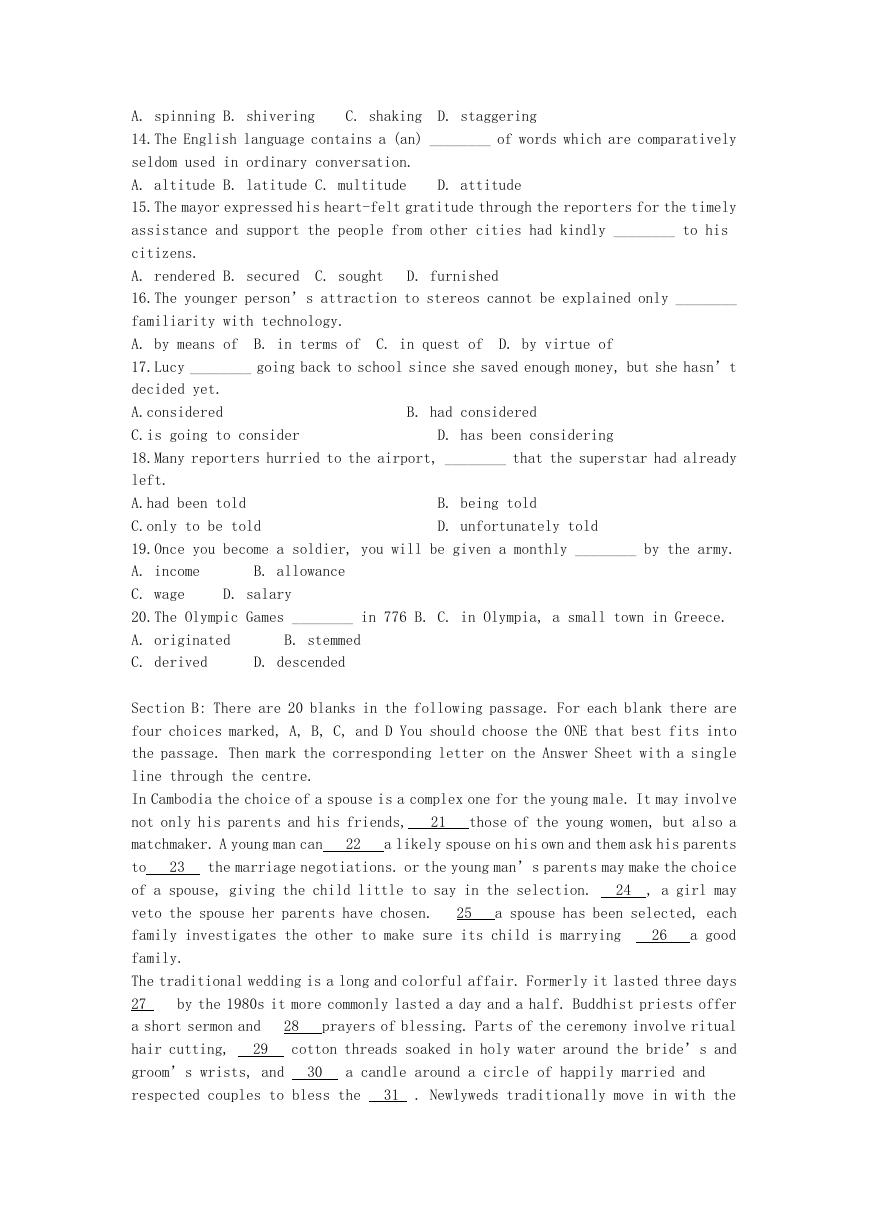
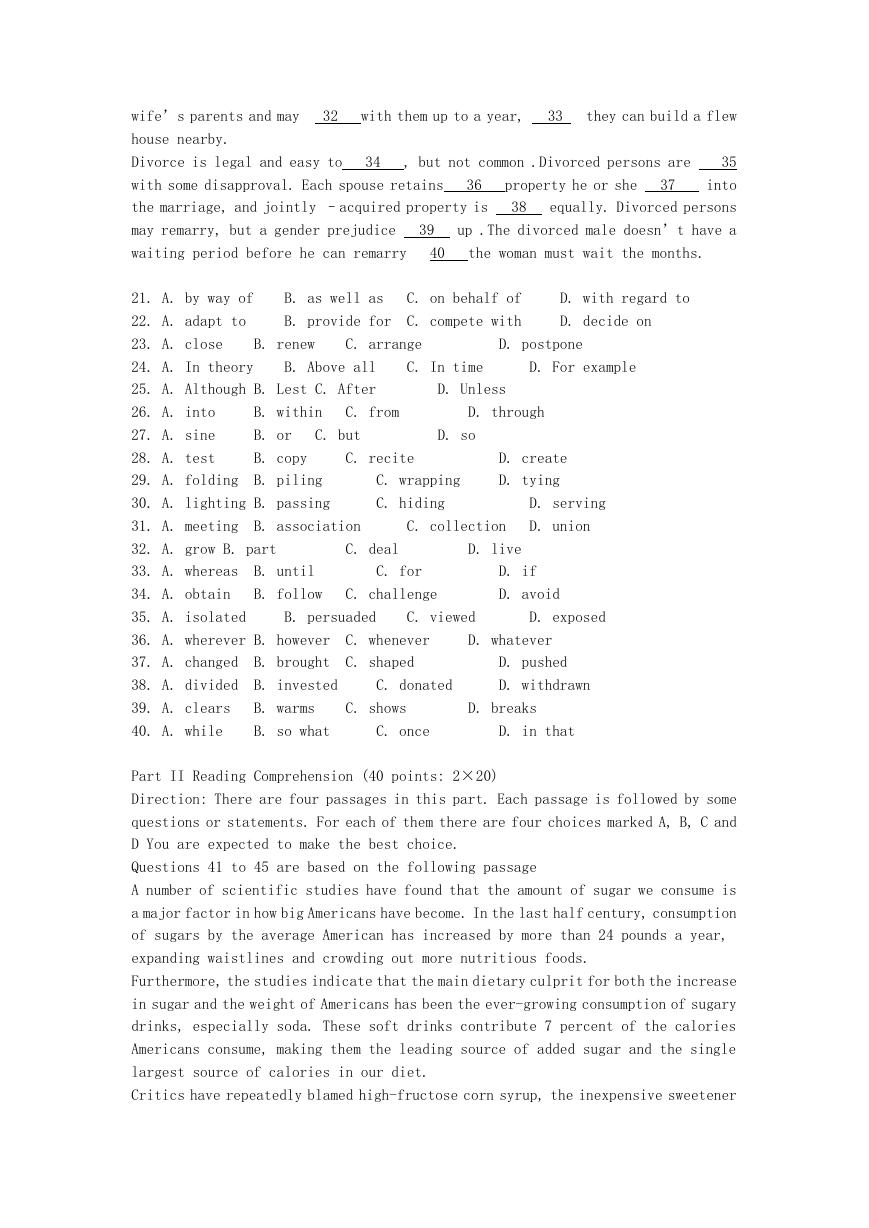
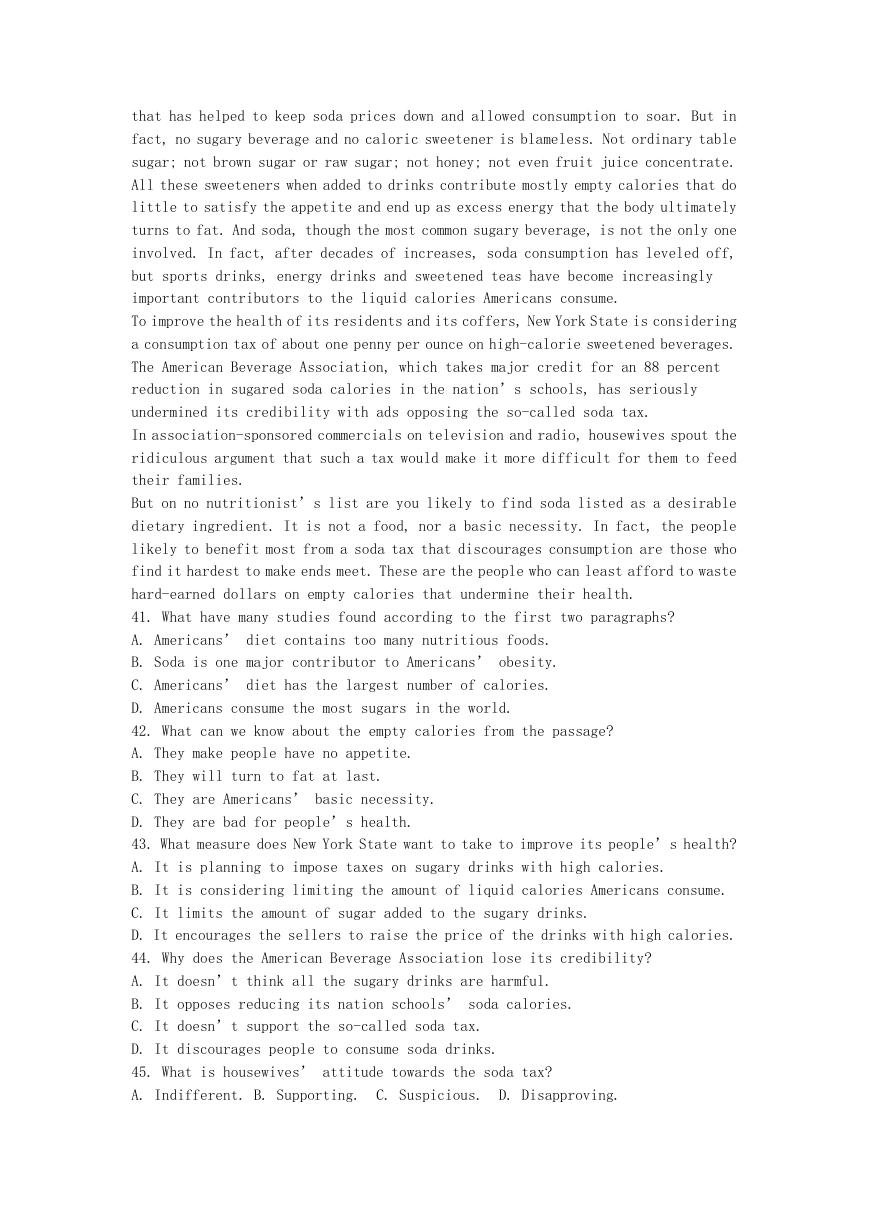
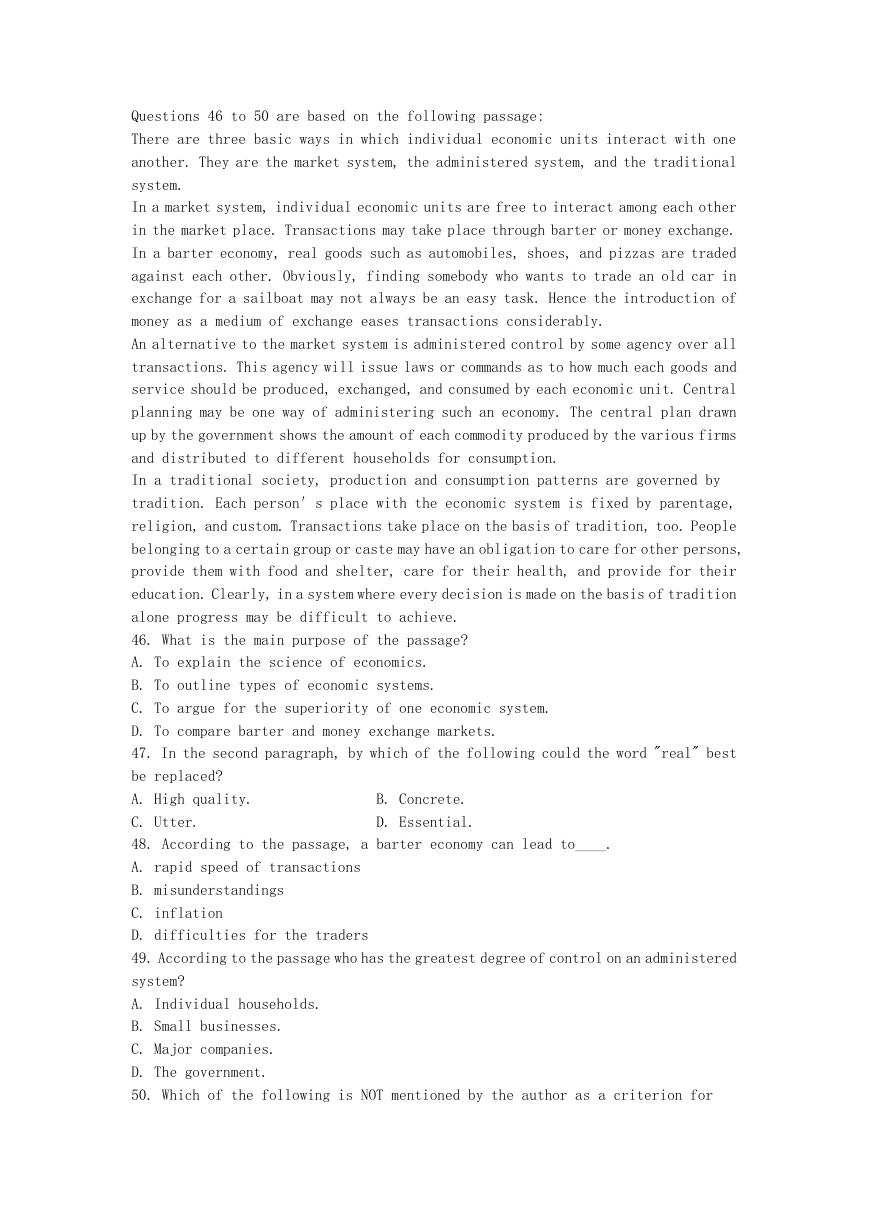
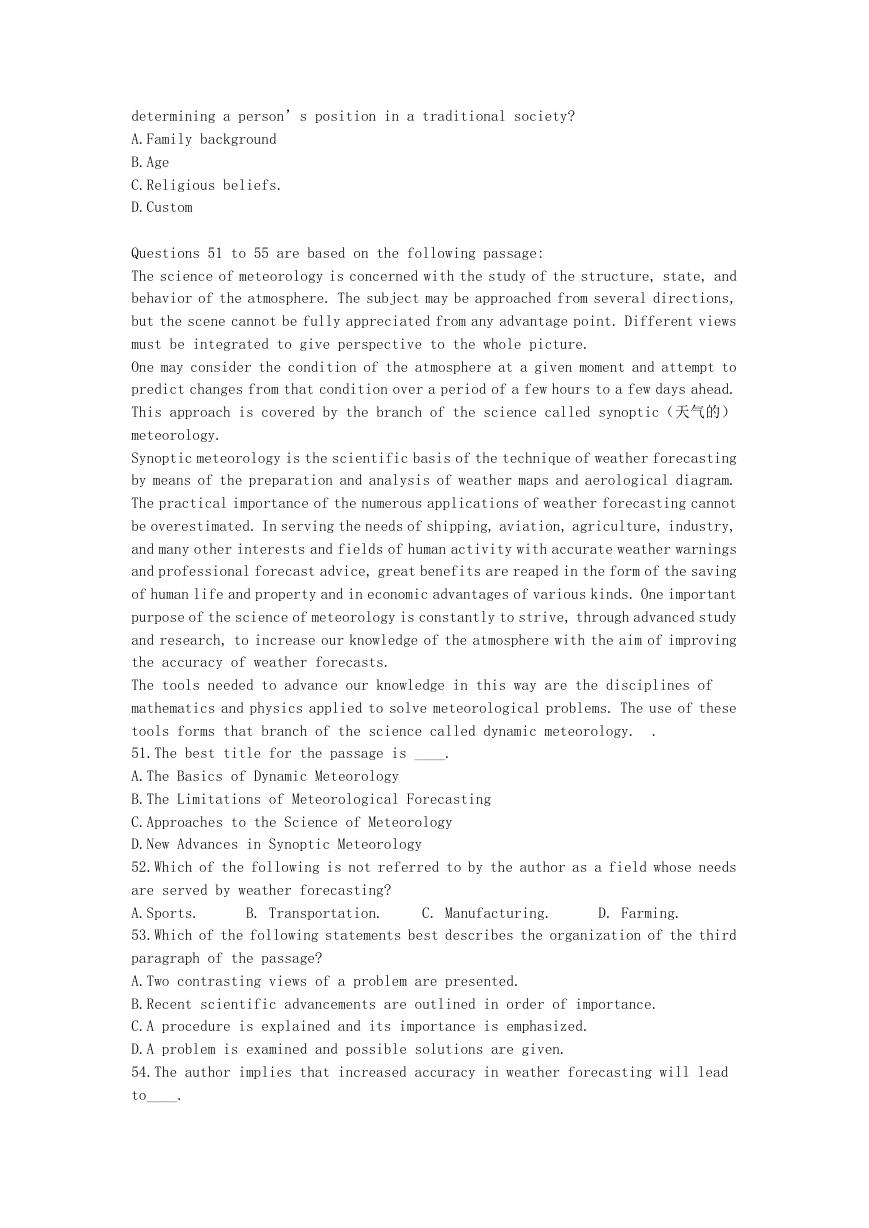

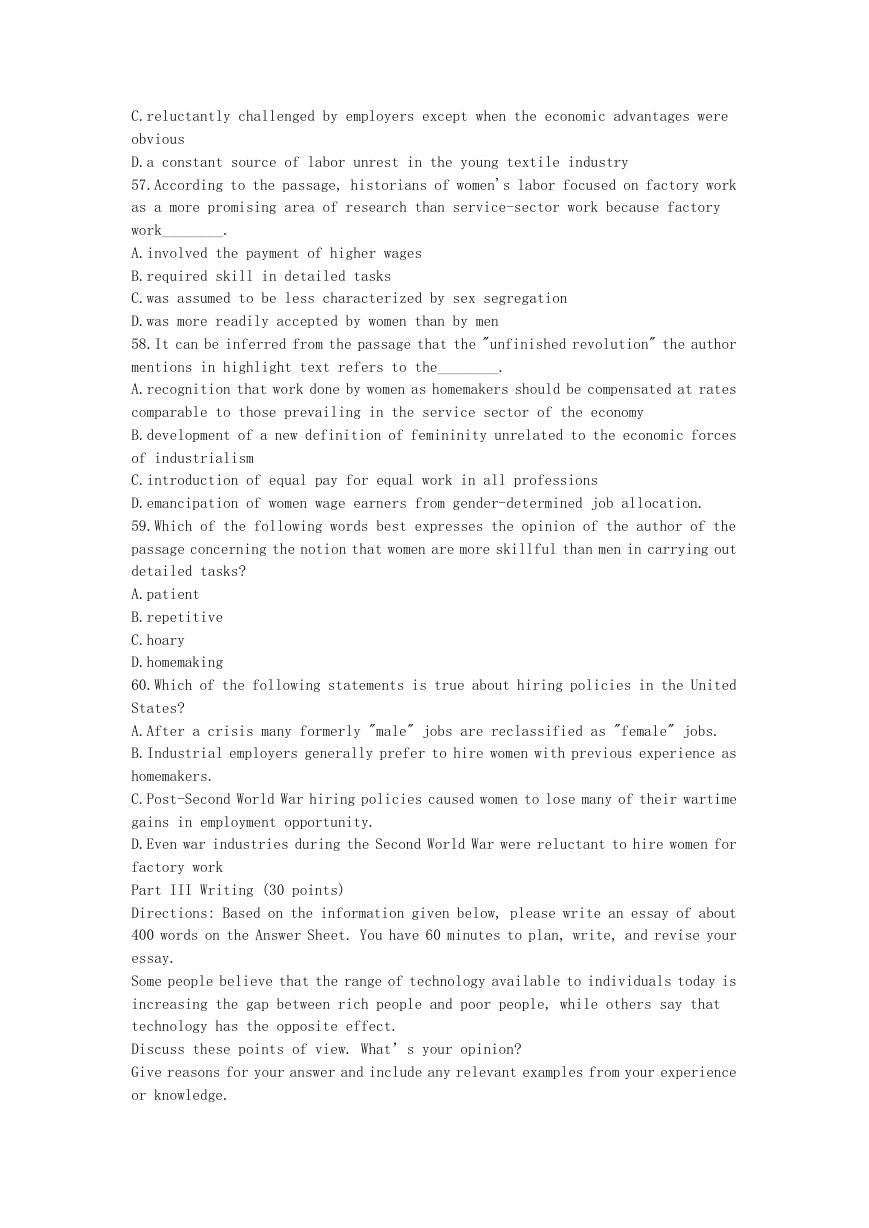








 2023年江西萍乡中考道德与法治真题及答案.doc
2023年江西萍乡中考道德与法治真题及答案.doc 2012年重庆南川中考生物真题及答案.doc
2012年重庆南川中考生物真题及答案.doc 2013年江西师范大学地理学综合及文艺理论基础考研真题.doc
2013年江西师范大学地理学综合及文艺理论基础考研真题.doc 2020年四川甘孜小升初语文真题及答案I卷.doc
2020年四川甘孜小升初语文真题及答案I卷.doc 2020年注册岩土工程师专业基础考试真题及答案.doc
2020年注册岩土工程师专业基础考试真题及答案.doc 2023-2024学年福建省厦门市九年级上学期数学月考试题及答案.doc
2023-2024学年福建省厦门市九年级上学期数学月考试题及答案.doc 2021-2022学年辽宁省沈阳市大东区九年级上学期语文期末试题及答案.doc
2021-2022学年辽宁省沈阳市大东区九年级上学期语文期末试题及答案.doc 2022-2023学年北京东城区初三第一学期物理期末试卷及答案.doc
2022-2023学年北京东城区初三第一学期物理期末试卷及答案.doc 2018上半年江西教师资格初中地理学科知识与教学能力真题及答案.doc
2018上半年江西教师资格初中地理学科知识与教学能力真题及答案.doc 2012年河北国家公务员申论考试真题及答案-省级.doc
2012年河北国家公务员申论考试真题及答案-省级.doc 2020-2021学年江苏省扬州市江都区邵樊片九年级上学期数学第一次质量检测试题及答案.doc
2020-2021学年江苏省扬州市江都区邵樊片九年级上学期数学第一次质量检测试题及答案.doc 2022下半年黑龙江教师资格证中学综合素质真题及答案.doc
2022下半年黑龙江教师资格证中学综合素质真题及答案.doc